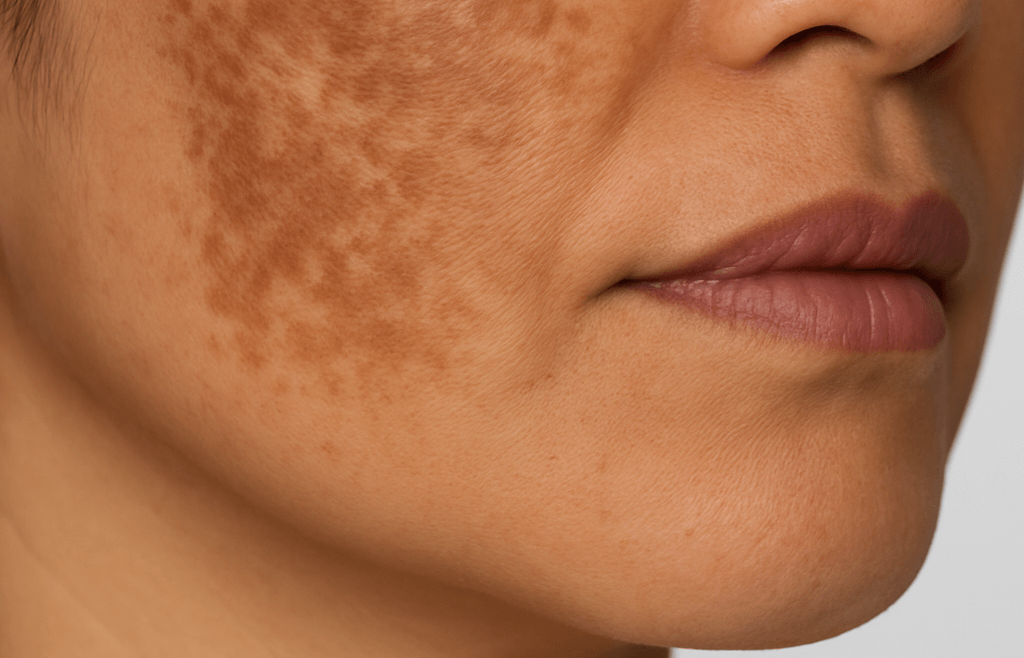Introduction
Skin discoloration is one of the most common concerns clients bring to Sculpt Med Spa in Downtown LA and Silverlake. But not all dark spots are the same. Two of the most frequently confused conditions are hyperpigmentation and melasma. While both involve uneven skin tone, the causes, triggers, and treatment approaches differ.
Here’s what you need to know about each—and how to choose the right treatment for your skin.
What Is Hyperpigmentation?
Hyperpigmentation refers to darkened patches of skin caused by an overproduction of melanin (the pigment that gives skin its color).
What Is Hyperpigmentation?
Hyperpigmentation refers to darkened patches of skin caused by an overproduction of melanin (the pigment that gives skin its color).
Common Causes of Hyperpigmentation:
- Sun exposure and UV damage
- Post-inflammatory hyperpigmentation (after acne, eczema, or injury)
- Certain medications or skin treatments
- Aging (age spots or liver spots)
- These effects are temporary and typically subside within 24–48 hours.
How It Appears:
- Dark spots or patches that may vary in size and shape
- Can occur anywhere on the face or body
- Often worsens with sun exposure
What Is Melasma?
Melasma is a chronic skin condition that causes symmetrical patches of darker skin, typically on the face. It is often triggered by hormonal changes.
Common Triggers of Melasma:
- Hormonal shifts (pregnancy, birth control, menopause)
- Sun exposure
- Genetic predisposition
- Heat or certain skincare products
How It Appears:
- Brown or gray-brown patches, usually on the cheeks, forehead, nose, or upper lip
- Symmetrical pattern on both sides of the face
- More common in women, especially with medium-to-darker skin tones
Key Differences Between Hyperpigmentation and Melasma
| Factor | Hyperpigmentation | Melasma |
|---|---|---|
| Cause | Sun damage, acne, injury, aging | Hormones, genetics, sun exposure |
| Appearance | Dark spots or patches, irregular | Symmetrical brown/gray patches |
| Location | Face & body | Primarily the face |
| Treatment | Topicals, lasers, chemical peels | More resistant, requires consistent care |
Treatment Options at Sculpt Med Spa
At Sculpt Med Spa in DTLA and Silverlake, we offer advanced treatments that address both hyperpigmentation and melasma:
- LaseMD Ultra skin rejuvenation– Targets sun damage, pigmentation, and uneven tone
- RF microneedling treatments like Morpheus8– Improves skin texture and stimulates collagen while reducing pigmentation
- Chemical peels – Gently exfoliate to fade dark spots
- Medical-grade skincare – Brightening serums and pigment inhibitors
Looking for a more comprehensive refresh? Pair pigmentation treatments with Botox or dermal fillers like Sculptra for total facial rejuvenation.
FAQs: Hyperpigmentation vs. Melasma
Can melasma go away on its own?
Melasma may fade over time, especially if it was pregnancy-induced, but it often requires treatment and ongoing sun protection.
Is hyperpigmentation permanent?
Not usually. With the right treatments—like lasers or peels—most cases improve significantly.
Which condition is harder to treat?
Melasma is generally more stubborn and prone to recurrence, while hyperpigmentation responds more quickly to treatment.
How many sessions will I need?
This depends on the severity of your pigmentation. Many clients notice improvement after 1–2 treatments, with best results from a series.
Can I prevent dark spots?
Yes—daily sunscreen, avoiding excessive sun exposure, and using medical-grade skincare can help prevent both hyperpigmentation and melasma.
Why Choose Sculpt Med Spa for Pigmentation Concerns?
Whether you’re struggling with stubborn melasma or sun-induced hyperpigmentation, our expert providers at Sculpt Med Spa in Downtown Los Angeles and Silverlake create customized treatment plans to restore clarity and balance to your complexion.
Book your consultation today to take the first step toward clearer, more radiant skin.


Leave a reply